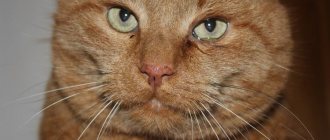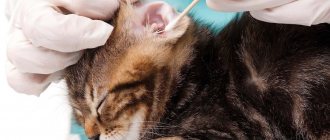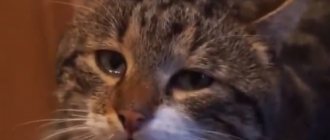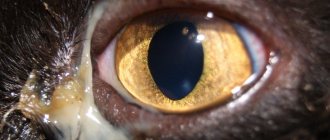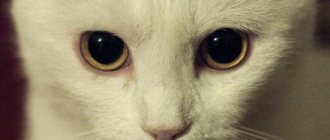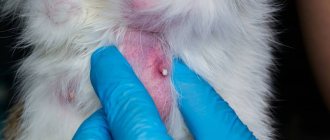Have you noticed changes in your pet? The eye is swollen, the cat often rubs its face, and tears flow from the corners? In this article, we will tell you what diseases and causes may cause ophthalmological problems in your pet, what you can do and what preventive measures will help you maintain your cat’s health.
The eyes are the main sensory organ through which cats perceive the outside world. Nature has endowed cats with acute vision (six times sharper than that of humans), and sometimes by looking into them, we can see the entire Universe.
This sense organ is not only the dignity and adornment of a beautiful animal, but also one of its weakest points. Very often, pets develop diseases that put the clarity and health of their vision at risk. It is important for every responsible owner to know what a pet’s healthy eyes look like and for what symptoms it is necessary to take it to the veterinarian.
Eye swelling in cats can signal a potential problem.
The cat's eye is swollen
Swelling of this organ is one of the main symptoms of most eye diseases. The main thing is not to ignore it, hoping that it is just temporary and everything will go away on its own. So, what to do?
What could be the consequences of ignoring this problem? For example, to loss of vision, which affects the behavior, activity and mood of your pet. Perhaps you think that everything is quite simple, the cat just hit its eye and you need to wait a couple of days? I hasten to inform you that swelling of the eye can signal more complex problems, ranging from internal pathologies to a malignant tumor. Treat this symptom with caution and do not neglect to consult a veterinarian
Types of eyelid diseases and their treatment
Symptoms and methods of treating eye diseases in cats depend not only on the cause, but also on the area of the lesion. The main blow is always taken by the eyelids, which protect the more delicate layers from the aggressive influence of the external environment.
Blepharitis
Staphylococcal infections that enter the eye cause unilateral or internal blepharitis in cats. This disease is accompanied by severe redness and inflammation of the corners of the eyelid, as well as the discharge of purulent exudate. Dried pus gradually covers the entire affected area, causing thickening and ulceration of the skin.
In addition to infection, blepharitis can be caused by allergies or demodicosis. Inflammation is treated with antibiotics, antihistamines or acaricidal drugs.
Third eyelid prolapse
This term refers to the transparent nictitating membrane, which performs a protective and moisturizing function. It is located in the inner corner of the eye next to the nose. Its loss is accompanied by uncontrollable twitching of the eyelids, lacrimation and copious discharge of pus or mucus.
Pathology develops with infections, allergies, parasitosis, foreign objects and fusion of the eyelids with each other. To reduce it, they resort to surgery.
Entropion of the eyelids
An alternative name for this disease is entropion. Most often it affects the lower eyelid, causing photophobia and excessive lacrimation. With entropion, it is very easy to understand that something is wrong with the cat’s eye, because she experiences severe pain due to prickly eyelashes and hairs.
The pathology is caused by congenital disorders, injuries and neoplasms. The problem is eliminated by excision of excess skin and formation of the correct palpebral fissure.
Ptosis
Characterized by involuntary drooping of the upper eyelid. The diseased eye opens only partially, and the palpebral fissure narrows. Ptosis occurs as a result of complications of inflammatory processes, paralysis of the facial nerve or weakness of the orbicularis muscle covering the anterior parts of the orbit. It is treated exclusively by surgery.
Lagophthalmos
External signs of lagophthalmos are similar to ptosis. The difference is that the eyelids cannot close. Because of this, the cat has to sleep with its eyes open. The causes and treatment are the same as ptosis.
Fusion of the eyelids with each other or with the conjunctiva
The first type of disorder is called ankyloblepharon, and the second - symblepharon. These pathologies develop from birth, with chronic blepharitis and as a result of mechanical damage. Both cases are accompanied by tissue scarring and the inability to open the eyes. To eliminate the fusion, the help of a surgeon is required.
Causes of eye tumors in cats
Here is a list of diseases why such a symptom as swollen eyes appears in a cat:
- Trauma or bruise
- Foreign body
- Entropion (etripon)
- Conjunctivitis
- Keratitis
- Eye damage by helminths
- Tumor
Each disease has additional symptoms that can indicate the nature of the problem and ways to solve it. We will talk about them below.
Pay attention to your pet's behavior - this will help you more accurately identify the problem.
Why do kitten eyes fester?
Before you begin treating your kitten, it is important to identify why the kitten’s eyes are purulent. All the main reasons can be divided into two groups:
- Mechanical reasons. These can be wounds, specks, bruises, eyelid inversions and many other harmless phenomena. Newborns can involuntarily injure each other with small claws, fall out of the bed, and so on. If renovation work is going on in the house, clouds of dust rise up in the room, which get into the eyes and cause inflammation. Tobacco smoke works on the same principle. Older cats begin to lead an active lifestyle: they play and fight. Entertainment becomes the main cause of scratches and various injuries.
- Diseases. Viral infections, conjunctivitis, chlamydia, blepharitis, allergies and much more. They are transmitted from the mother, through milk, or acquired through improper care and feeding. Stray cats are more likely than domestic cats to have viral diseases of the eyeballs.
Reference. British scientists have concluded that conjunctivitis in one third of kittens is caused by chlamydia. The viral disease occurs in furry fidgets aged 1 to 9 months. Chlamydia is transmitted to healthy kittens by contact from infected kittens.
Injury
If your cat is active, plays a lot, runs and jumps, then the eye may be swollen due to a bruise. And if your pet is very warlike, then most likely he could get damaged in a fight. In any case, you definitely won’t be able to find out on your own, because the cat won’t be able to tell you that it took part in the fight for territory. And cats don't bruise.
If your kitten is acting restless, or you notice swelling, redness or tears, then he is most likely damaged. Cold compresses can help in this case.
Feed your cat food rich in vitamin A, which speeds up the regeneration and restoration of the skin.
If the amount of tear secretions increases, then you should not delay visiting the veterinarian, since during a fight the cat could damage the cornea of the eye. Without timely treatment, your pet may lose the injured eye.
Symptoms
Although this condition is quite common, you should make sure your cat receives immediate veterinary care as soon as you notice any of the following symptoms:
- Excessive tearing
- Presence of tears, especially if they are opaque
- Yellow discharge from the eyes
- Red or swollen third eyelid
- Squinting or keeping your eyes closed
- Excessive flashing
© shutterstock
Foreign body
Cats are by nature inquisitive creatures, and exploration and exploration of new territory is the norm for them. Your pet could injure and get debris into its eye while exploring the neighbor's bushes, or even indoor plants.
If you notice that your kitten is blinking frequently, rubbing its eye with its paw, or there is swelling, redness and discharge, then you should do an initial examination. The swelling may be hot to the touch.
When you are convinced that there is a foreign object in the cat’s eye, think several times about whether you should remove it yourself? After all, one awkward move and you can damage your eye irrevocably. It is better to call a veterinarian at home and follow his further recommendations.
If you rarely brush your pet, its own hair can easily get into the eye and cause irritation of the cornea.
The color of the discharge from the eyes matters
It is important for the pet owner to carefully look at the color of the discharge coming from the eyes.
If they are transparent, similar to ordinary tears, then this may be due to the characteristics of the breed, mechanical irritation, or the occurrence of an allergic reaction.
If yellow or green discharge appears, in which pus is present, we can say that there is an infectious disease.
If a cat's eyes are watery red or brown, then there is a high probability that the cat is infected with worms.
Entropion (etropion)
This is a pathological condition in which the upper or lower eyelid turns towards the eyeball. This disease can be influenced by various factors: hereditary, acquired or age-related.
There are cat breeds in which the occurrence of entropion is increased (Persian, Maine Coon, Siamese, Sphynx, Scottish, British). This is due to the fact that the ligaments on the inside of the eye are weakened, and with age and decreased immunity, they become even more flabby and the eyes are attacked by viruses and bacteria, which leads to the occurrence of etropion.
In fact, all cats in old age (over 10 years old) are susceptible to this disease, and it can develop in both eyes and affect both the upper and lower eyelids.
Acquired factors include: injuries to the eyeball and other eye diseases (viral, infectious, fungal, neoplasms).
At the initial stage, the symptoms of volvulus can be confused with conjunctivitis: there is a fear of light, frequent blinking, and slight lacrimation. Further, the symptoms worsen: the eyelids swell, become red, the discharge becomes cloudy and increases in size. The Cat loses its appetite and interest in what is happening. With all the symptoms, it is important to know that the animal is feeling increasing pain.
The most important thing here is not to treat your pet’s eyes yourself, but to take them to a veterinary clinic for diagnostics. After all, the eyes are a very sensitive organ; we cannot know for sure that we will not harm the pet with our desire to help right now.
Eye diseases accompanied by the production of tears
There are several different eye conditions in pets that cause tear production:
- Infection. If the eye is noticeably swollen and red, and there is discharge of pus, then the help of a veterinarian is definitely needed to prevent the development of feline conjunctivitis.
- Directly eye diseases, in particular glaucoma or cataracts. A clouded cornea in the first case or a whitened lens in the second are the most obvious symptoms of these diseases. Of course, you definitely need to go to a clinic for treatment.
- Diseases caused by fungi or viruses (such as toxoplasmosis or chlamydia) can only be cured by a veterinarian.
- Inflammation of the cornea can be identified by reddened and very watery eyes, on which a soapy film forms.
- Some breeds experience entropion of the eyelid - usually Sphynxes or Persians. The appearance of swollen eyes and suppuration in their eyes is a reason to visit a veterinarian as soon as possible.
- Eye injuries that a cat can get if it fights with its fellow tribesmen, hits itself, or gets caught on some branches. Wounds or other damage to the eyeballs are obvious symptoms of this injury. It is recommended to consult a veterinarian to determine the severity of the damage.
Conjunctivitis
As a rule, this disease is rarely registered as an independent disease. Most often, this is a signal of the presence of other problems: mechanical injuries, infectious diseases, parasitic worms in the eyeball, eyelash growth inside the eyelid (trochiasis), and even incorrectly selected dry food.
Symptoms of conjunctivitis:
- Photophobia;
- Swelling and redness;
- Frequent washing of the face;
- Decreased appetite;
- Discharge (which increases and the eye sticks together).
Causes of the disease
A large group of inflammatory processes in the conjunctiva, which have significant differences in causes, epidemiology, dynamics, prognosis, etc., is collectively called “conjunctivitis.” In ophthalmological practice, various classifications of conjunctivitis are used, but, as a rule, they emphasize the etiopathogenetic factor, i.e. causes and mechanisms of inflammation, for example:
- infectious conjunctivitis:
- viral;
- bacterial;
- fungal;
- allergic conjunctivitis;
- dystrophic conjunctivitis;
- chronic conjunctivitis (usually caused by prolonged mechanical, ultraviolet or chemical irritation, chronic gastrointestinal diseases, endocrine disorders, inadequate treatment or self-medication);
- parasitic conjunctivitis, etc.
The first two types are the most common; In general, conjunctivitis is considered the most common diagnosis in ophthalmology, and especially in children's.
Reference
In almost 60% of cases of conjunctivitis infection, symptoms appear in only one eye, and after a few days the second eye is involved in the process.
When the first symptoms are detected, to alleviate the condition, you need to provide the animal with rest in a room with dim light, and also rinse the eyes with an antiseptic solution. Next, contact a veterinarian to make a correct diagnosis, conduct diagnostics and prescribe treatment.
There is also a risk for humans of contracting conjunctivitis from a cat.
Treatment of conjunctivitis in children
Obviously, the treatment of conjunctivitis is determined by the factors that caused it. It is the prerogative of the doctor to establish these reasons, and in this case there is no need to speculate, for example, “The year before last there was diathesis, which means allergic conjunctivitis.” As first aid, it is allowed to wash the eyes with decoctions with aseptic and soothing properties (chamomile, sage, regular tea leaves), special solutions of furatsilin or boric acid.
Any eye bandages are contraindicated: if the conjunctivitis is bacterial, the bandage will contribute to the accumulation of mucopurulent secretions infested with the pathogen, which then dry out, stick the eyelids together, cause additional irritation, and infect the second eye (if the inflammation began in one). You should remember the importance of following asepsis rules, and provide the child with individual bed linen, towels, etc. The pipette, if needed, should have rounded edges to avoid even accidental injury.
Further treatment will be prescribed by the doctor, as they say, according to indications.
Keratitis in cats
Another one of the most common ophthalmological diseases in cats. Keratitis is an inflammation of the cornea. You can recognize it immediately by a clouded eye.
This disease can also occur due to other reasons: foreign body, conjunctivitis, eye burns (difficult to treat), allergies, infection, vitamin deficiency, inflammation of the lacrimal glands, genetic predisposition (most often artificially bred cats are prone to this disease - Siamese, Persians, British).
In addition to clouding of the cornea, you need to pay attention to a number of symptoms that will confirm your fears:
- Manifestation of blood vessels;
- Severe photophobia;
- Fluid accumulation inside the eye;
- The appearance of scars (indicates that the disease is at the last stage and further treatment will most likely not bring any results).
As you probably already understood, independent treatment is contraindicated, and first you need to find out the causes of keratitis. You can examine the eye for the presence of foreign bodies, assess the general condition, but only a qualified veterinarian can determine the severity of the disease and prescribe treatment.
Cloudiness of the eyeball indicates the possibility of more complex internal diseases.
How to treat?
When a cat's visual organs are swollen and lumps appear above the eye, it is important to take him to the veterinarian. Self-treatment can cause serious harm to your pet's health. The treatment regimen is selected by the veterinarian depending on what disease has been diagnosed. If the problem is minor and swelling is observed due to inflammation of the mucous membrane, it is recommended to resort to a weak solution of hydrogen peroxide. Dip a cotton swab into the liquid and gently wipe the cat's eyelids.
You can treat a cat using Furacilin solution. Medicinal herbs, for example, sage and chamomile, will also come to the rescue. They have a bactericidal effect, help relieve swelling and stop inflammatory processes. If the cat is calm, veterinarians from the Zovet clinic recommend using a cold compress. It should be applied to the affected organ, which will eliminate pain and swelling.
Eye damage by helminths
It is believed that worms in the eyes of a cat is a myth, but you should know that theoretically these parasites can live in any organ. It is important to remember that helminths of this type are very dangerous and your pet may simply lose his sight if treatment is not started in time.
How do these parasites get into a cat's eyes? They require an intermediate carrier – fruit flies. They sit on the animal’s eyelids, lay eggs close to the mucous membrane, and when the pet washes itself, they inseminate it. After the development stage, the egg develops into a larva, which moves into the eyeball and begins to grow.
Symptoms that indicate that the eye is affected by helminths:
- Loss of eyelashes;
- Itching in the eye area;
- lacrimation;
- Inflammation of the mucous membrane and cornea
- Cloudiness
- Increased body temperature
- Deterioration of vision (blindness)
This symptomatology is well known to us and is very similar to other ophthalmological diseases that we have already listed. A definitive diagnosis can only be made in a clinical setting.
Preventive actions
- As we said earlier, special attention must be paid to the nutrition of your pet. If you are faced with the problem of severe lacrimation, first of all, analyze your pet’s menu. Just like humans, our smaller brothers should not overindulge in sweets, smoked meats, fried and fatty foods, as well as baked goods. Create a balanced menu for your pet, eliminating harmful foods and those that can cause an allergic reaction.
- When bathing an animal, be sure to ensure that detergents (shampoos, pastes, solutions) do not get into the eyes. Be especially careful when using products for fleas, ticks and other parasites.
- Do not allow the animal to be in drafts, especially immediately after washing the pet.
- Trim the long hair on the head and shorten the length of the eyelashes slightly, and also remove hair from the eye area using elastic bands and hairpins. This, of course, is more suitable for decorative breeds. The fact is that in many long-haired breeds, frequent profuse lacrimation is associated with eyelashes and fur getting into the eyes. If you are afraid to cut your dog's hair yourself, you can contact a groomer.
- Avoid contact of your pet with homeless and obviously sick animals.
- Do not neglect the constant preventive examination of your pet at the veterinary clinic.
Tumor
All of the previously listed diseases are, for the most part, treatable if the causes are identified in time. But there is a disease in which swelling in the eye area may indicate the presence of a neoplasm. If, in addition to the tumor, your pet begins to have difficulty oriented in space, or there is a noticeable disturbance in the coordination of movements, then conduct an independent examination.
If the swelling is hard and there is an increase in body temperature, this is a reason to sound the alarm and immediately take the animal to a veterinary clinic, this will increase the chances of a positive outcome and possible avoidance of surgical intervention.
If, during a self-examination, you notice that the swelling has a dense structure, then the best solution is to contact a veterinary clinic.
The most common diseases
The eyes are an extremely delicate organ. A cat can damage them after an unsuccessful jump or another street fight with representatives of its species.
Important! If you are sure that the cat suffered an eye injury after a walk, examine the rest of the body. Your pet could be the victim of a rabid animal. Rabies can be fatal within a few days. Moreover, your pet can infect you. Contact the specialists!
The cause of such changes in the functioning of the cat’s visual organs can be infections and hereditary diseases. If you have even slight suspicions, you should immediately contact your veterinarian. Perhaps the disease is in its early stages, and treatment will not take much effort or money.
Causes of swollen eyes in cats:
- mechanical injuries;
- allergy;
- contact of foreign objects with the mucous membrane of the eye;
- conjunctivitis;
- glaucoma, cataract;
- change in the position of the eyelid;
- infectious, viral disease;
- tumor.
Injuries
Traumatic swelling of the eyes can be seen in active cats after another unsuccessful acrobatic performance or after a comic fight with a fellow cat. Very often, adult kittens, when flirting, get a paw in the eye from their older comrades. Cats are smart animals that know how to calculate strength. Don't worry, if the swelling and redness are slight, the eye will recover after a while.
Cold compresses can help facilitate recovery. Add foods and food that contain vitamin A to your cat's menu. It helps speed up regenerative processes.
Monitor the changes: if your cat begins to secrete copious amounts of fluid and the tumor continues to grow, contact your veterinarian immediately. Such symptoms are observed when the cornea is damaged. Without timely intervention, this leads to partial loss of vision.
Allergy
We are what we eat. This aphorism can also be applied to our smaller brothers. If you don’t know what to do if your cat’s eye is swollen, try to find the cause in his diet. A new food, an exotic type of meat, one of your pet plants - all this can cause an allergic reaction in a cat. Consult your veterinarian, he will analyze your cat’s diet and help you create a diet.
Allergic reactions also include swelling after insect bites. Cats are very inquisitive, playful animals. They often play with flying insects. Wasps and bees can also be a source of entertainment for a playful kitten. The result is a swollen eye for several days. To reduce itching and burning at the bite site, apply cold compresses.
Foreign objects
If you find a foreign object in your cat's eye, think twice before removing it yourself. One careless movement can cause your pet to lose the ability to see. Do not poke into the eye with bare hands under any circumstances; use sterile gloves and tweezers. Prepare a solution for rinsing the eye after the procedure. For these purposes, use furatsilin and boiled water.
If the animal is in critical condition, call specialists to your home. In this case, carrying out treatment on your own is extremely risky. Several thousand are not worth the loss of such an important sense organ as vision.
Conjunctivitis
Conjunctivitis occurs in a cat's eye due to infection. The main symptoms of this disease are constant discharge of pus and fear of light. Before going to the clinic, experts advise rinsing your eye several times a day to slow down the development of symptoms. For these purposes, use specialized drops, a weak solution of potassium permanganate, boric acid, black tea, and chamomile decoction.
Conjunctivitis is often a symptom of a more serious illness, so consultation with a veterinarian is necessary in any case. The doctor will examine the animal and prescribe the necessary tests.
Glaucoma
A sure sign of glaucoma is a noticeable increase in the size of the eyeball. This occurs due to increased pressure of the eye fluid. To treat this disease, ointments and drops are prescribed. Do not try to choose medications on your own. Your pet may have an individual intolerance.
Cataract
Cataracts are a disease that affects almost all older cats. It is characterized by slight swelling of the eye and clouding of the pupil. If you notice these symptoms, then you no longer have time to think about what to do if your cat has a swollen eye. Immediate surgical intervention is needed. Don't waste time.
Changing the position of the eyelid
This symptom may be a consequence of other ophthalmological diseases. The inversion of the eyelid goes away on its own after some time. To speed up the process, you can use soothing ointments and drops. If the eyelid does not return to its original position after a long time, surgery is performed.
Infection
This concept covers a wide range of causes of redness and swollen eyes in cats. Keep in mind that some infectious animal diseases that are caused by parasites can be transmitted to their owners. Protect the sick animal from people with weak immune systems and children. Visit your veterinarian regularly. Constant surveillance allows you to track the dynamics of the disease and provide effective treatment.
Tumor
Feel around the cat's eye. If there is a solid formation there, this is a reason to sound the alarm. Pets are not immune to tumor development. The sooner you contact a veterinarian, the better the chance that the tumor will not have to be removed surgically.
Treatment of eye tumors
During the examination, the doctor will take the necessary tests from the animal; in case of swelling of the eye, an urgent biopsy will most likely be required. The results will show whether the tumor is benign or malignant.
Treatment of cancer in cats requires a comprehensive approach and depends on the degree of development of the disease. Therapy consists of surgery, radiation and chemotherapy. The choice of treatment depends on the type of cancer cells, the location of the cancer, and the presence of metastases. To treat cancer in pets, surgery is often used.
But surgery is not always the way to recover a pet. Sometimes a veterinarian may prescribe radiation or chemotherapy to stop the progression of the disease or to exclude possible relapses.
Apathy, disorientation, and lack of appetite may indicate the presence of cancer.
The Scottish Fold cat's eyes are watery: why?
It was previously mentioned that certain breeds of pets have a non-standard nasolacrimal duct, and among them the British, Scottish and Persian breeds stand out. Due to such features, the lacrimal canal is not able to fully remove secretions, which are the norm for all other breeds. In this case, the excess comes out through the eyes. If this happens after the animal has slept, then there is no reason to worry. This phenomenon is normal from a physiological standpoint.
If your pet constantly produces tears, this is no longer considered normal, so you need to seek the help of a veterinarian to find out the reasons.
Such animals need to wash their eyes once a week or more often, and in some cases up to 2-3 times a day. With a normal level of discharge, it is quite enough to simply wipe them periodically.
If your cat's eyes often water, it is recommended to bring the animal to the veterinarian for a full examination.
Prevention of eye diseases
To prevent your pet from having eye problems, it is important to take some measures to prevent ophthalmic diseases:
- If your animal goes outside, then inspect the eyes daily for the presence of foreign bodies and the absence of injuries;
- The house should be clean to avoid allergic reactions and also debris;
- Brush your pet more often, because when washing, hair can also get into the mucous membrane of your pet’s eyes;
- Vaccination is very important, because thanks to it the cat has a strong immune system and is less susceptible to infectious diseases;
- Monitor your pet’s diet so that it receives a sufficient amount of vitamins through food;
- Mandatory deworming every 4-6 months.
Regarding cancer, there are no methods of prevention. Not a single animal is safe from it. Cats die from cancer just like other pets, dogs. It has been proven that various factors provoke cancer, one of them is chronic diseases, which can be avoided by applying preventive measures.
Preventative measures will help avoid further illnesses in your pet.
How to eliminate tearing?
In order to help your pet, it is not enough just to consult a veterinarian and purchase the appropriate product. You should definitely know how to use it correctly in order to help and not harm your pet. Here is a list of simple but very effective rules:
- Wash your hands to avoid spreading dirt and infection into your pet's eyes.
- Take saline or chlorhexidine. There is no need to use tea leaves or unstrained herbal decoctions for this procedure, since a fine fraction can cause even more problems for the animal, which is important to avoid in case of conjunctivitis and other diseases. Gently use a cotton swab dipped in saline solution or warm water to clean the hair around the eyes and eyelid area. The saline solution will simply remove dirt from the eyes. But if the eyes are not only watery, but irritated and inflamed, then it is better to use chlorhexidine as a preventive measure for inflammation. This product is completely safe for your animal and will not cause any pain.
- Tilt your pet's head back and try to fix the position with one hand. Here you will need firmness and confidence in your movements, as well as a strong grip, otherwise the dog may suddenly break free and get hurt during burying. It is better, of course, to carry out this eye cleaning together, because... Not all pets like hygiene procedures. Be sure to praise your pet after the procedure and give him something tasty!
- How to wash a dog’s eyes at home if they are very watery or if a foreign object has gotten into them? Again, we suggest using chlorhexidine or vetericin. We have already talked about the benefits of chlorhexidine earlier. In this case, it is better to even use vetericin, because it relieves irritation faster and destroys more germs. Place the product in the eyes and let the dog blink. Be calm, your pet will not be hurt. Vetericin, like chlorhexidine, does not pinch or burn.
- As for humans, the ointment is placed in the conjunctival sac. To do this, the eyelid is pulled back a little, and the product is squeezed into the resulting pocket.
- My dog's eye is watering, what should I do? Be sure to use the product prescribed by your veterinarian in both eyes. This must be done not only for treatment, but also for eye prevention.

